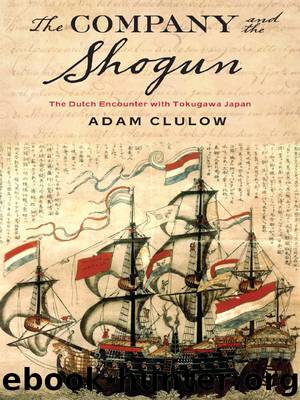The Company and the Shogun by Adam Clulow

Author:Adam Clulow
Language: eng
Format: epub
Tags: HIS021000, History/Asia/Japan, POL045000, Political Science/Colonialism & Post-Colonialism
Publisher: Columbia University Press
Published: 2014-01-13T16:00:00+00:00
CHAPTER FIVE
POWER AND PETITION
If we called pirates all those who maintain their rights with weapons, then we would find few princes and kings in the world but only pirates.
—Governor-General Antonio van Diemen, 1642
In 1663 seven half-dead Chinese sailors washed up onto the Gotō Islands, a small chain located near the coast of Kyushu. Their ship had departed Chaozhou in Guangdong province a few weeks earlier on its way to Japan but had run into a fierce storm that had swept away one of its masts. As the crew struggled to rig new sails, they sighted an unfamiliar Dutch ship on the horizon. It was not there to help, and, after refusing to submit to an inspection, the Chinese junk came under fire, heavy cannon shot from the Dutch ship ripping into their vessel’s hull. Forced to abandon ship, the surviving mariners, clinging desperately to the wreckage, were tossed by the sea for days before favorable currents washed them onto Japanese shores. The casualty list, both as a consequence of the bombardment and later in the cold waters of the East China Sea, was high. So too were the damages from the lost vessel and the rich cargo it had carried. Determined to extract full compensation from the company for their lossses, the survivors moved quickly to file a petition with the Nagasaki bugyō, the highest-ranking Bakufu official on Japan’s maritime frontiers.
The resultant document and others like it that were submitted by Chinese plaintiffs to Tokugawa authorities in protest of VOC actions form the subject of this analysis. In contrast to chapter 4, which considered a period when the Bakufu permitted, and in some ways actively encouraged, maritime trade through the shuinjō system, this chapter examines a later period during which Tokugawa foreign policy was defined by a series of maritime restrictions, the so-called closed country or sakoku edicts, promulgated between 1633 and 1639, that seem to mark a determined withdrawal from the sea. Given the fact that they combined to effectively shut down Japan’s merchant marine, these edicts seem to suggest an almost total abdication of responsibility over the ocean and an open pass for an organization like the Dutch East India Company to act as it saw fit on the sea lanes leading into Japan. But if we look more closely at the Dutch experience in these years a very different picture emerges. Even as it dramatically reduced the volume of maritime traffic moving in and out of the archipelago, the Tokugawa regime continued to cast a long shadow over the ocean.
To highlight this ongoing influence, this chapter shifts the focus away from the shogun’s court in Edo, where debates over attacks on Portuguese shipping played out, to consider the rise of Nagasaki as its own space for petition, investigation, and arbitration. The key protagonists of this story are Chinese or tōjin (literally, people of Tang) merchants, a diverse community of traders that was concentrated in Nagasaki after 1635. With no access to Edo, they turned to the Nagasaki bugyō who became an active participant in maritime disputes involving the Dutch.
Download
This site does not store any files on its server. We only index and link to content provided by other sites. Please contact the content providers to delete copyright contents if any and email us, we'll remove relevant links or contents immediately.
| Arms Control | Diplomacy |
| Security | Trades & Tariffs |
| Treaties | African |
| Asian | Australian & Oceanian |
| Canadian | Caribbean & Latin American |
| European | Middle Eastern |
| Russian & Former Soviet Union |
The Secret History by Donna Tartt(18947)
The Social Justice Warrior Handbook by Lisa De Pasquale(12166)
Thirteen Reasons Why by Jay Asher(8846)
This Is How You Lose Her by Junot Diaz(6833)
Weapons of Math Destruction by Cathy O'Neil(6215)
Zero to One by Peter Thiel(5732)
Beartown by Fredrik Backman(5679)
The Myth of the Strong Leader by Archie Brown(5457)
The Fire Next Time by James Baldwin(5382)
How Democracies Die by Steven Levitsky & Daniel Ziblatt(5172)
Promise Me, Dad by Joe Biden(5113)
Stone's Rules by Roger Stone(5052)
A Higher Loyalty: Truth, Lies, and Leadership by James Comey(4906)
100 Deadly Skills by Clint Emerson(4880)
Rise and Kill First by Ronen Bergman(4739)
Secrecy World by Jake Bernstein(4700)
The David Icke Guide to the Global Conspiracy (and how to end it) by David Icke(4657)
The Farm by Tom Rob Smith(4465)
The Doomsday Machine by Daniel Ellsberg(4449)
